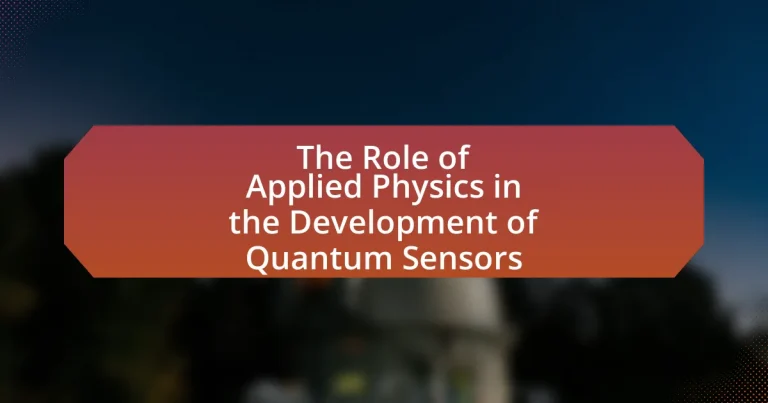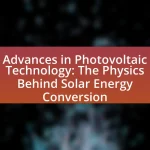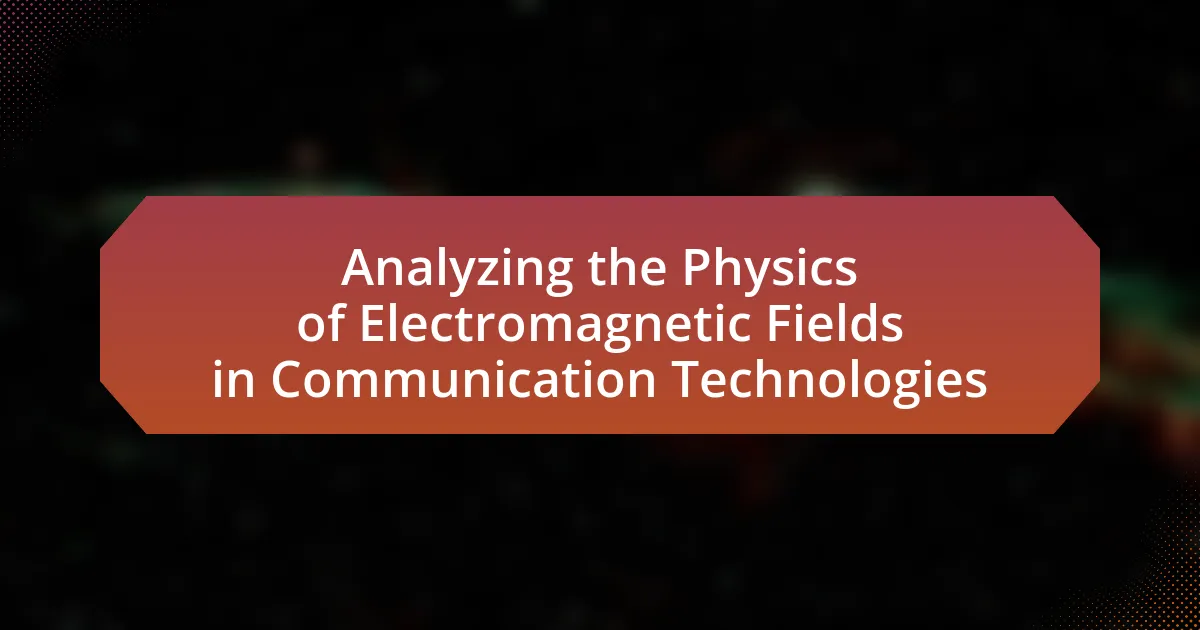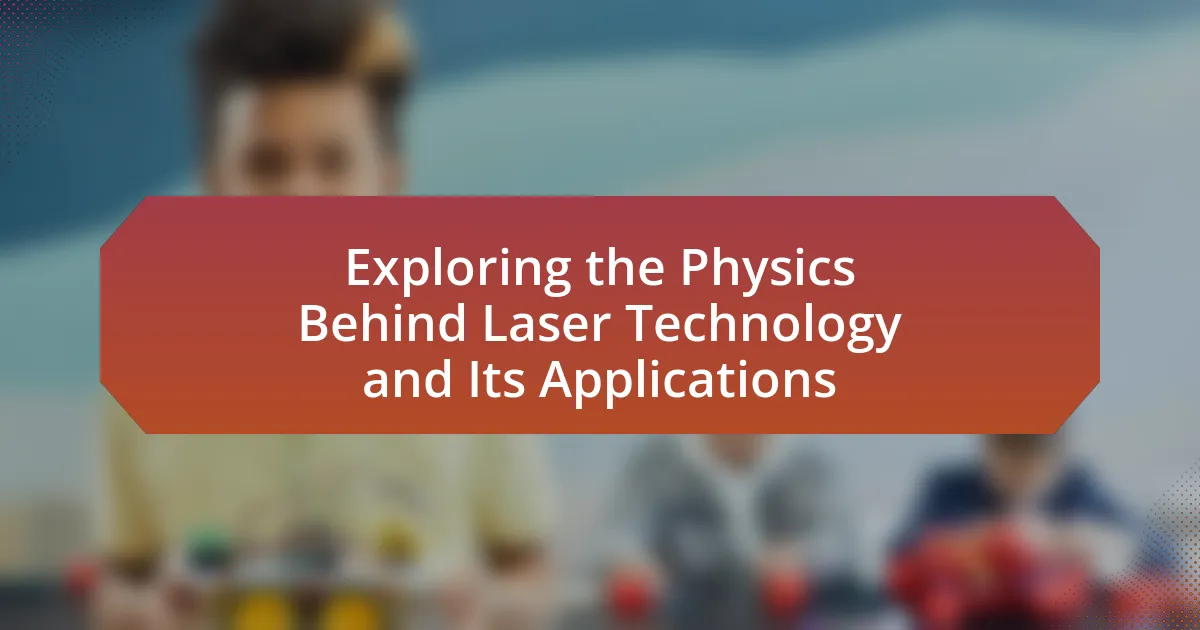Applied physics is integral to the advancement of quantum sensors, providing the theoretical framework and experimental techniques necessary to exploit quantum phenomena such as superposition and entanglement. This article explores how applied physics contributes to the principles of quantum sensing, detailing key concepts like quantum coherence and their role in enhancing measurement sensitivity. It also examines various types of quantum sensors, including atomic interferometers and superconducting devices, and their applications in fields such as healthcare, navigation, and environmental monitoring. Furthermore, the article highlights recent breakthroughs in applied physics that have influenced quantum sensor development and discusses future trends and best practices for optimizing sensor performance.

What is the Role of Applied Physics in the Development of Quantum Sensors?
Applied physics plays a crucial role in the development of quantum sensors by providing the theoretical framework and experimental techniques necessary for harnessing quantum phenomena. This discipline enables the design and optimization of sensors that exploit quantum superposition and entanglement, leading to enhanced sensitivity and precision in measurements. For instance, applied physics principles are utilized in the development of atomic clocks, which achieve unprecedented accuracy by leveraging quantum states of atoms. Research has shown that quantum sensors can outperform classical sensors by several orders of magnitude in specific applications, such as gravitational wave detection and magnetic field sensing, demonstrating the significant impact of applied physics on advancing sensor technology.
How does applied physics contribute to the principles of quantum sensing?
Applied physics significantly contributes to the principles of quantum sensing by providing the foundational understanding of quantum mechanics and the development of technologies that exploit quantum phenomena. This field enables the design and optimization of sensors that utilize quantum states, such as superposition and entanglement, to achieve unprecedented sensitivity and precision in measurements. For instance, applied physics principles are integral in creating atomic clocks and magnetometers that leverage quantum coherence, resulting in timekeeping and magnetic field measurements with accuracies surpassing classical methods. The advancements in materials science and nanotechnology, driven by applied physics, also enhance the performance of quantum sensors by improving their stability and reducing noise, thereby validating the effectiveness of quantum sensing in practical applications.
What fundamental concepts of applied physics are utilized in quantum sensors?
Quantum sensors utilize fundamental concepts of applied physics such as superposition, entanglement, and quantum coherence. Superposition allows quantum systems to exist in multiple states simultaneously, enhancing measurement sensitivity. Entanglement enables correlated states between particles, which can improve precision in measurements. Quantum coherence maintains the phase relationship between quantum states, crucial for accurate sensor functionality. These principles collectively enable quantum sensors to achieve unprecedented sensitivity and accuracy in various applications, including magnetic field detection and timekeeping, as evidenced by advancements in atomic clocks and magnetometers.
How do these concepts enhance the sensitivity of quantum sensors?
The concepts of superposition and entanglement enhance the sensitivity of quantum sensors by allowing them to exploit quantum states that are more responsive to external influences. Superposition enables sensors to measure multiple states simultaneously, increasing the likelihood of detecting subtle changes in the environment. Entanglement, on the other hand, allows for correlations between particles that can amplify measurement precision, as demonstrated in experiments where entangled photons improve the accuracy of measurements beyond classical limits. These principles lead to enhanced sensitivity in applications such as gravitational wave detection and magnetic field sensing, where even minute variations can be detected with high fidelity.
Why is applied physics essential for advancing quantum sensor technology?
Applied physics is essential for advancing quantum sensor technology because it provides the theoretical framework and experimental techniques necessary to manipulate quantum states for enhanced measurement precision. Quantum sensors leverage principles such as superposition and entanglement, which are grounded in applied physics, to achieve sensitivity beyond classical limits. For instance, research has shown that quantum sensors can detect gravitational waves with unprecedented accuracy, as demonstrated by the LIGO experiment, which utilized applied physics concepts to achieve its groundbreaking results. This integration of applied physics into quantum sensor development enables innovations that significantly improve measurement capabilities across various fields, including navigation, medical imaging, and environmental monitoring.
What breakthroughs in applied physics have influenced quantum sensor development?
Breakthroughs in applied physics that have influenced quantum sensor development include advancements in superconductivity, quantum entanglement, and precision measurement techniques. Superconductivity has enabled the creation of highly sensitive sensors, such as superconducting quantum interference devices (SQUIDs), which can detect minute magnetic fields. Quantum entanglement has facilitated the development of sensors that exploit correlations between particles to achieve unprecedented sensitivity and accuracy. Additionally, precision measurement techniques, such as atom interferometry, have allowed for the detection of gravitational waves and other subtle physical phenomena, enhancing the capabilities of quantum sensors. These breakthroughs collectively contribute to the enhanced performance and application range of quantum sensors in various fields, including navigation, medical imaging, and fundamental physics research.
How does applied physics address challenges in quantum sensor design?
Applied physics addresses challenges in quantum sensor design by providing the theoretical and experimental frameworks necessary for understanding quantum phenomena and enhancing sensor performance. For instance, applied physics principles enable the development of advanced materials and techniques that improve sensitivity and accuracy in quantum sensors, such as superconducting materials used in quantum interference devices. Additionally, applied physics contributes to the optimization of quantum algorithms and error correction methods, which are crucial for maintaining the integrity of quantum measurements. These advancements are supported by empirical research, such as studies demonstrating the effectiveness of quantum entanglement in increasing measurement precision, thereby validating the role of applied physics in overcoming design challenges in quantum sensors.

What are the key types of quantum sensors developed through applied physics?
The key types of quantum sensors developed through applied physics include atomic interferometers, superconducting quantum interference devices (SQUIDs), and quantum-enhanced magnetometers. Atomic interferometers utilize the wave-like properties of atoms to measure gravitational fields with high precision, as demonstrated in experiments that achieve sensitivity beyond classical limits. SQUIDs exploit quantum tunneling to detect extremely weak magnetic fields, making them essential in applications like medical imaging and geophysics. Quantum-enhanced magnetometers leverage entangled states to improve measurement accuracy, with advancements shown in detecting magnetic fields at the nanoscale. These types of sensors illustrate the significant impact of applied physics in enhancing measurement capabilities through quantum principles.
What are the main categories of quantum sensors?
The main categories of quantum sensors include atomic sensors, superconducting sensors, and photonic sensors. Atomic sensors utilize the properties of atoms, such as their energy levels and coherence, to measure physical quantities with high precision. Superconducting sensors leverage the unique characteristics of superconducting materials to detect magnetic fields and other phenomena at extremely low temperatures. Photonic sensors exploit quantum properties of light, such as entanglement and superposition, to achieve sensitive measurements in various applications. Each category demonstrates distinct advantages in sensitivity and accuracy, making them suitable for different measurement challenges in applied physics.
How do atomic sensors differ from superconducting sensors?
Atomic sensors utilize the quantum properties of atoms, such as their spin or energy levels, to measure physical quantities like magnetic fields or temperature, while superconducting sensors rely on the unique electrical properties of superconductors, particularly their ability to conduct electricity without resistance, to detect changes in magnetic fields or other signals. Atomic sensors typically achieve high sensitivity through techniques like laser cooling and trapping, whereas superconducting sensors, such as superconducting quantum interference devices (SQUIDs), exploit quantum interference effects to achieve sensitivity at very low temperatures. The fundamental difference lies in their operational principles: atomic sensors are based on atomic physics, while superconducting sensors are grounded in condensed matter physics.
What applications are best suited for each type of quantum sensor?
Quantum sensors are best suited for applications in precision measurement, imaging, and navigation. Atomic interferometers excel in measuring gravitational waves and detecting inertial forces, while superconducting qubit sensors are ideal for magnetic field detection in medical imaging, such as MRI. Quantum-enhanced sensors, like those based on squeezed light, are effective in improving the sensitivity of optical measurements, particularly in gravitational wave astronomy. Additionally, nitrogen-vacancy centers in diamonds are utilized for nanoscale magnetic field sensing, making them valuable in materials science and biology. Each type of quantum sensor leverages unique quantum properties to enhance measurement capabilities in their respective fields.
How do quantum sensors leverage quantum mechanics principles?
Quantum sensors leverage quantum mechanics principles by utilizing phenomena such as superposition and entanglement to achieve high sensitivity and precision in measurements. These sensors exploit the unique properties of quantum states, allowing them to detect minute changes in physical quantities like magnetic fields, temperature, and time with unprecedented accuracy. For instance, atomic clocks, which are a type of quantum sensor, use the oscillations of atoms in superposition to measure time with an accuracy of one second over billions of years, demonstrating the practical application of quantum mechanics in enhancing measurement capabilities.
What role does superposition play in the functionality of quantum sensors?
Superposition is fundamental to the functionality of quantum sensors as it allows quantum systems to exist in multiple states simultaneously, enhancing measurement precision. This property enables quantum sensors to detect minute changes in physical quantities, such as magnetic fields or gravitational forces, by leveraging the interference patterns that arise from superposed states. For instance, in atomic interferometry, superposition is utilized to create interference fringes that can measure variations in gravitational acceleration with unprecedented accuracy, demonstrating the practical application of superposition in improving sensor sensitivity and resolution.
How does entanglement enhance measurement precision in quantum sensors?
Entanglement enhances measurement precision in quantum sensors by allowing correlated quantum states to provide more accurate readings than classical states. This correlation enables the sensors to achieve a higher sensitivity to external perturbations, effectively reducing the uncertainty in measurements. For instance, in quantum metrology, entangled particles can surpass the standard quantum limit, achieving precision that scales with the number of entangled particles, as demonstrated in experiments involving atomic clocks and gravitational wave detectors. This phenomenon is supported by the Heisenberg uncertainty principle, which states that entangled states can minimize measurement errors, thereby improving the overall performance of quantum sensors.

What are the practical applications of quantum sensors in various fields?
Quantum sensors have practical applications across various fields, including healthcare, navigation, and environmental monitoring. In healthcare, quantum sensors enable highly sensitive magnetic resonance imaging (MRI), allowing for improved diagnosis and treatment monitoring. In navigation, quantum sensors enhance the precision of inertial navigation systems, which are crucial for aircraft and submarines, providing accurate positioning without reliance on GPS. Environmental monitoring benefits from quantum sensors through their ability to detect minute changes in magnetic fields, aiding in the exploration of natural resources and monitoring of climate change effects. These applications demonstrate the transformative potential of quantum sensors in advancing technology and improving quality of life.
How are quantum sensors utilized in medical diagnostics?
Quantum sensors are utilized in medical diagnostics primarily for their ability to detect minute changes in physical quantities, such as magnetic fields and temperature, with high precision. These sensors enhance imaging techniques, such as magnetic resonance imaging (MRI), by improving signal-to-noise ratios, which allows for clearer and more accurate images of biological tissues. For instance, research has shown that quantum-enhanced MRI can detect subtle variations in tissue properties, aiding in the early diagnosis of conditions like cancer. Additionally, quantum sensors can be employed in biomarker detection, enabling the identification of specific proteins or genetic material associated with diseases at extremely low concentrations, thus facilitating timely and accurate diagnoses.
What advantages do quantum sensors offer in imaging techniques?
Quantum sensors provide enhanced sensitivity and precision in imaging techniques. They exploit quantum phenomena, such as superposition and entanglement, to achieve measurements that surpass classical limits. For instance, quantum sensors can detect minute changes in magnetic fields or gravitational forces, enabling high-resolution imaging in medical diagnostics and materials science. Research has shown that quantum-enhanced imaging can improve signal-to-noise ratios significantly, allowing for clearer images in applications like MRI and microscopy. This capability stems from the fundamental principles of quantum mechanics, which allow for the manipulation of information at the quantum level, leading to advancements in imaging technologies.
How do quantum sensors improve the accuracy of biological measurements?
Quantum sensors enhance the accuracy of biological measurements by utilizing quantum phenomena such as superposition and entanglement to achieve unprecedented sensitivity and precision. These sensors can detect minute changes in physical quantities, such as magnetic fields or temperature, which are critical in biological contexts. For instance, quantum sensors can measure biomagnetic fields generated by neural activity with high fidelity, enabling more accurate mapping of brain functions. Research has demonstrated that quantum-enhanced measurements can achieve sensitivity levels that surpass classical sensors by orders of magnitude, allowing for the detection of single molecules or subtle biological signals that would otherwise remain undetected.
What impact do quantum sensors have on environmental monitoring?
Quantum sensors significantly enhance environmental monitoring by providing unprecedented sensitivity and precision in detecting changes in environmental parameters. These sensors utilize quantum phenomena, such as superposition and entanglement, to measure variables like temperature, pressure, and magnetic fields with high accuracy. For instance, a study published in Nature Communications demonstrated that quantum sensors can detect minute variations in gravitational fields, which can be used to monitor groundwater levels and track subsurface changes, thereby aiding in resource management and disaster prevention. This capability allows for real-time monitoring of environmental conditions, leading to more effective responses to climate change and pollution.
How can quantum sensors detect subtle changes in environmental conditions?
Quantum sensors detect subtle changes in environmental conditions by leveraging quantum phenomena such as superposition and entanglement. These sensors utilize highly sensitive quantum states to measure variations in physical quantities like temperature, magnetic fields, and pressure with unprecedented precision. For instance, atomic interferometers, a type of quantum sensor, can detect minute changes in gravitational fields, which can indicate shifts in mass distribution or geological activity. Research has shown that quantum sensors can achieve sensitivity levels surpassing classical sensors by several orders of magnitude, enabling them to identify changes as small as a fraction of a nanometer in distance or a few picoteslas in magnetic field strength.
What specific environmental applications benefit from quantum sensing technology?
Quantum sensing technology benefits several specific environmental applications, including precise monitoring of greenhouse gas emissions, detection of pollutants in air and water, and assessment of soil quality. For instance, quantum sensors can detect methane and carbon dioxide at extremely low concentrations, enabling accurate tracking of emissions from industrial sites and natural sources. Additionally, these sensors can identify trace levels of contaminants in water bodies, improving environmental monitoring and compliance with safety standards. Research has shown that quantum-enhanced sensors can achieve sensitivity levels that surpass classical methods, making them invaluable for environmental protection and management.
What are the future trends in the development of quantum sensors?
Future trends in the development of quantum sensors include advancements in sensitivity, miniaturization, and integration with classical systems. Researchers are focusing on enhancing the sensitivity of quantum sensors, such as atomic clocks and magnetometers, to detect weaker signals and improve measurement precision. Miniaturization efforts aim to create compact quantum sensors that can be deployed in various environments, including mobile and remote applications. Additionally, the integration of quantum sensors with classical technologies is expected to enhance their functionality and broaden their application range, particularly in fields like healthcare, navigation, and environmental monitoring. These trends are supported by ongoing research and development initiatives, such as those reported in the journal “Nature” by authors including H. J. Kimble and A. M. Steinberg, which highlight the potential of quantum technologies to revolutionize sensing capabilities.
How might advancements in applied physics shape the next generation of quantum sensors?
Advancements in applied physics will significantly enhance the capabilities of the next generation of quantum sensors by improving their sensitivity, accuracy, and operational range. For instance, developments in materials science, such as the creation of superconducting materials and topological insulators, enable quantum sensors to operate at higher temperatures and with reduced noise, leading to more precise measurements. Additionally, innovations in quantum entanglement and coherence time can increase the performance of sensors used in fields like navigation, medical imaging, and environmental monitoring. Research has shown that these advancements can lead to quantum sensors that outperform classical sensors by orders of magnitude, as evidenced by studies demonstrating enhanced magnetic field detection capabilities in quantum magnetometers.
What emerging technologies could integrate with quantum sensors for enhanced performance?
Emerging technologies that could integrate with quantum sensors for enhanced performance include artificial intelligence, machine learning, and advanced materials. Artificial intelligence and machine learning can optimize data analysis from quantum sensors, improving accuracy and efficiency in interpreting complex datasets. Advanced materials, such as topological insulators and superconductors, can enhance the sensitivity and stability of quantum sensors, enabling them to operate in more challenging environments. These integrations are supported by ongoing research demonstrating that AI algorithms can significantly reduce noise in quantum measurements, while advanced materials have been shown to improve coherence times in quantum systems, thus validating their potential for enhancing quantum sensor performance.
What best practices should be followed in the development of quantum sensors?
Best practices in the development of quantum sensors include ensuring high coherence times, minimizing environmental noise, and optimizing sensor design for specific applications. High coherence times are crucial as they allow quantum states to remain stable long enough for accurate measurements; for instance, superconducting qubits have demonstrated coherence times exceeding 100 microseconds. Minimizing environmental noise, such as electromagnetic interference, is essential to maintain the integrity of quantum states; techniques like shielding and cryogenic cooling are commonly employed to achieve this. Additionally, optimizing sensor design involves tailoring the sensor’s parameters to the specific physical phenomena being measured, which enhances sensitivity and accuracy. These practices are supported by ongoing research and advancements in quantum technology, demonstrating their effectiveness in improving quantum sensor performance.




